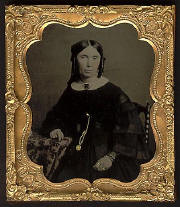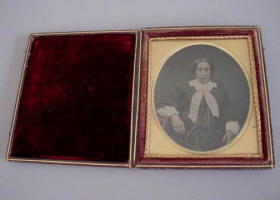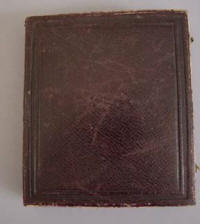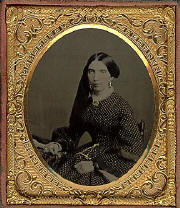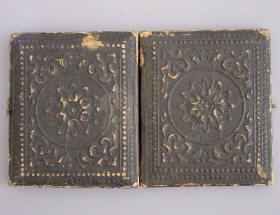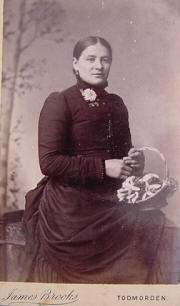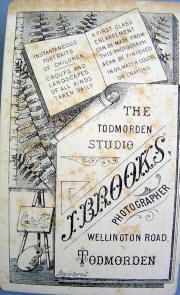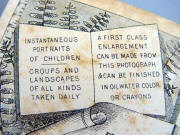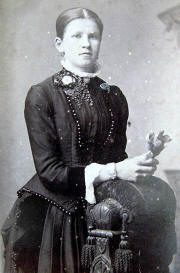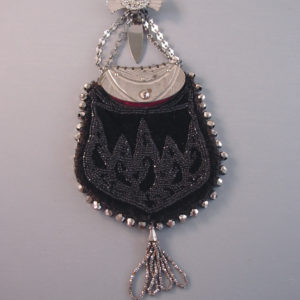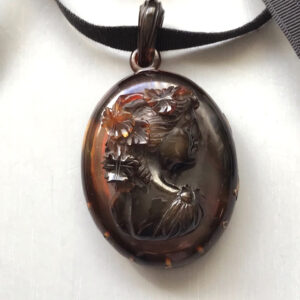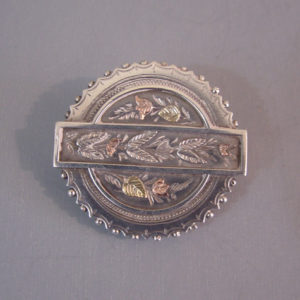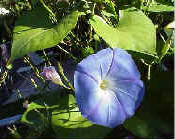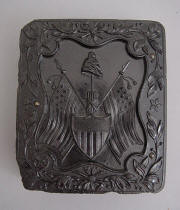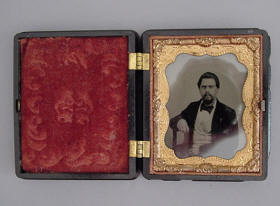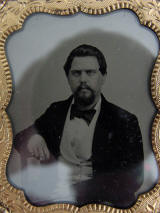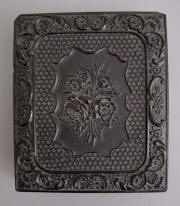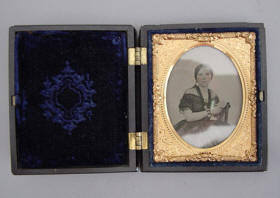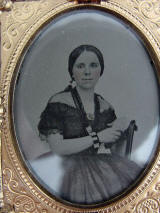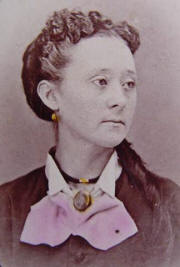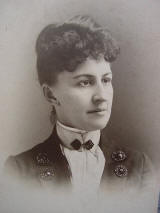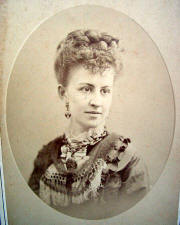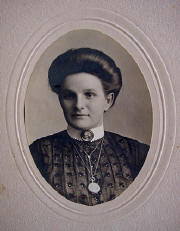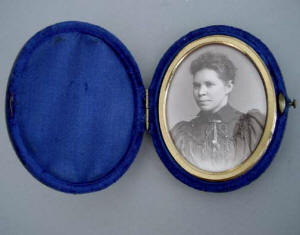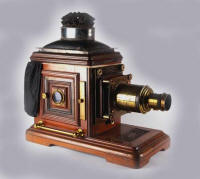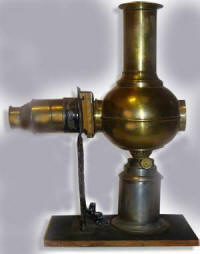|
|
|
Daguerreotypes
Daguerreotypes were images produced on a silver-coated
copper plate. The process was in 1839 invented by Louis Jacques Mande Daguerre
(1787 to 1851), a Frenchman who had formerly been a stage designer, set
painter and creator of dioramas. Daguerreotypes most popular from about the
1840s to the 1860s. One way they can be recognized is by the high contrast
brilliance with bright whites and deep blacks. Because of the long exposure
time and the serious approach most sitters had to the process of having
their image documented, daguerreotypes often show people with a fairly stiff
and stern expression. Daguerreotypes could be hand-tinted, usually with gold
highlighting any jewelry in the picture, and perhaps pink in the cheeks.
Daguerreotypes allowed only one image and duplicates could not be produced.
|
VICTORIAN daguerreotype of a lady wearing
a hair brooch, a watch chain and pocket watch, bracelets and rings, all
highlighted with gold paint. |
VICTORIAN
daguerreotype of a lady wearing jewelry; a large brooch, jet beaded bracelet
and a simple band ring.
View
View
View |
VICTORIAN daguerreotype of a lady wearing jewelry;
earrings, brooch, bracelets, rings and a watch and chain, all touched with
gold.. |
|
Ambrotypes
Ambrotypes were negative images on a glass plate, made
positive by the addition of a black backing, and each image was
one-of-a-kind. Frederick Scott Archer, an
Englishman, introduced this process in 1854, and it was done from
the mid 1850s to the mid 1890s, with the height of it’s popularity during
the Civil War. Ambrotypes are not as high-contrast as
daguerreotypes so the images will be shades of gray with no bright whites.
Because they were done on glass, they are more fragile than tintypes.
|
|
VICTORIAN ambrotype of a Civil
War era man in a patriotic case, 2-1/2" by 3" by 5/8", "Genuine Union Case".
View
View
View
View #A26620 |
VICTORIAN ambrotype of a Civil
War era man in a patriotic case, 2-1/2" by 3" by 5/8", "Genuine Union Case".
View
View
View
View #A26620 |
VICTORIAN ambrotype of a Civil
War era bejeweled woman with hand tinted cheeks in a floral Union case,
2-1/2" by 3" by 5/8".
View View
View
View #A26621 |
|
VICTORIAN ambrotype of a Civil
War era bejeweled woman with hand tinted cheeks in a floral Union case,
2-1/2" by 3" by 5/8".
View View
View
View #A26621 |
VICTORIAN ambrotype of a Civil
War era bejeweled woman with hand tinted cheeks in a floral Union case,
2-1/2" by 3" by 5/8".
View View
View
View #A26621 |
VICTORIAN ambrotype of a Civil
War era bejeweled woman with hand tinted cheeks in a floral Union case,
2-1/2" by 3" by 5/8".
View View
View
View #A26621 |
|
Tintypes, Ferrotypes
Tintypes were images produced in the negative on a thin
iron plate and made positive with an undercoating of black Japan varnish.
Invented by Prof. Hamilton Smith of Ohio, these were popular for a long period from the 1850s-1930s. Cased tintypes were last produced in
about 1867, but they were done in other forms through the first third of the
20th century. Because they were less expensive to produce than daguerreotype
and ambrotypes, more of them were made. They could be tinted as well.
|
VICTORIAN tin type of a
toddler.
View |
BACK of a Victorian tin type showing how it was taped into the
case. |
VICTORIAN tintype of two
ladies wearing fancy hats.
View |
|
Cases
Cases were made on a wooden base that would have been
covered in cloth, leather or paper mache and embossed. They were also molded
out of plastic made from shellac and wood fibers and these were called
"Union Cases". Floral and geometrical design were popular and common,
although patriotic and other more intricate motifs can be found as well.
Some cases were inlaid with mother-of-pearl.
|
|
VICTORIAN ambrotype of a Civil
War era man in a patriotic case with flags and shield, 2-1/2" by 3" by 5/8", "Genuine Union Case",
circa 1855. A similar case can be seen in Mace’s "Collector’s Guide to
Early Photographs, Ed. 2" on page 65.
View
View
View
View #A26620 |
VICTORIAN ambrotype of a Civil
War era bejeweled woman with hand tinted cheeks in a floral Union case,
2-1/2" by 3" by 5/8".
View View
View
View #A26621 |
VICTORIAN daguerreotype case.
|
|
Carte de Visite
Carte de Visites (visiting cards) were albumen prints
popularized on France by Andre Adolphe Eugene Disderi in about 1854. Popular
from the mid 1850s through about 1905, they usually measure approximately
2-1/2" by 3-1/2 to 4"" and are mounted on heavy paper cards that are slightly
larger than the image. These were exchanges with friends somewhat like
calling cards.
|
VICTORIAN lady carrying a basket of flowers and wearing a floral ornament at
her throat. Carte de visite size 2-1/2" by 4-1/8", marked on the front,
"James Brooks, Todmorden"… |
…and on the back, "instantaneous portraits of children- groups and
landscapes of all kinds taken daily- a first class enlargement can be made
from this photograph & can be finished in oil water color or crayons. The
Todmorden Studio, JB Brooks, Photographer, Wellington Road". |
VICTORIAN lady
wearing a buckle motif bracelet. Carte de visite marked "James Brooks,
The Todmorden Studio, Wellington Road". |
VICTORIAN lady wearing a jet bead choker and holding her
diary. Carte de visite size 2-1/2" by 4", marked on the front "W. J. Chivers, 10 Station Rd, Sutton" and on the back, a hand written note in
ink "Lizzie Gardner, Dec. 28th, 1886" as well as a printed ad for the
photographer. |
LADY wearing gold earrings and
a woven hair necklace with a photograph pendant. Carte de visite marked
"Robertson & Brooks, Franklin, KY." |
VICTORIAN lady wearing a
horseshoe bar pin for good luck and a floral bodice ornament. Carte de visite
signed "H. Walker, Bradford, 150 College Road, Manchester Rd, Bradford".
View |
|
Cabinet Cards
Cabinet cards were also albumen photographs. They were
approximately 4" by 5" and were mounted on cardboard, usually a 4-1/2" by 6-1/2" card. Popular from about 1863 to 1920, they
were introduced by the British firm of Windsor & Bridge.
|
|
VICTORIAN lady wearing a brooch with pendant on a
black beaded neck ribbon. Cabinet card marked on the back, "Sittler,
Springfield, Missouri, 1887".
View |
VICTORIAN lady wearing a
lovely lace collar and slide chain. Cabinet card marked "Kierski, S.E. Cor.
5th St. & Central Ave., Minneapolis". |
VICTORIAN
lady wearing a long chain. Cabinet card marked "Westervelt, New Ground Floor
Studio, 218 South Broadway, Los Angeles, Cal.". |
|
VICTORIAN lady wearing
cut steel pieces as a collar clasp and buttons. Cabinet card size
4-1/4" by 6-1/2", marked on the back, "from the Studio of Chas. H. Lindsey,
Photographer, Murgatroyd’s Block, Nashua, NH" and hand written in ink,
"James Minn Mch 17-1886, Mochurn Church Yard, Eli_g Cottage, Eli_g Village". |
VICTORIAN lady
wearing a vulcanite cameo
pendant and golden earrings. Cabinet card handwritten on the back in pencil,
"Lizzie Richardson".
View
View |
VICTORIAN lady wearing
a portrait brooch and pendant watch. Cabinet card in folder marked, "Miller,
Union Block, Mt. Vernon, O." and hand written in red ink on front, "Alta
Woodruff Houk, age 18".
View |
|
|
VICTORIAN cased photograph
of a lady wearing jewelry, dress ornamented with jet and glass beads, 2-1/2"
by 3" and 1/2" deep. Probably cut out from a cabinet card.
View
View #V32374 |
|
|
Stereoscopes & Magic
Lanterns
The stereoscope, while designed in the 1830s, was simplified
and presented first in the Crystal
Palace in London at the 1851
Great Exhibition. Stereo views can be found of people, cityscapes,
activities and stories. Viewing these three-dimensional photos was a popular parlor entertainment.
Early Magic Lanterns were used both by itinerant traveling "lanternists"
and in theaters. Slides could be hand painted or printed, and the
quality varied widely. By the 1900s, the magic lantern had evolved into the
slide projector.
|
|
VICTORIAN stereoscope "Expedition
Universelle International 1900, RC White & Co".
View
View #a28693 |
MAGIC LANTERN, a very upscale piece with wooden cabinet. |
MAGIC LANTERN a simpler version, all metal. |
|
